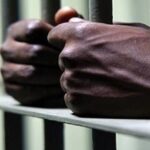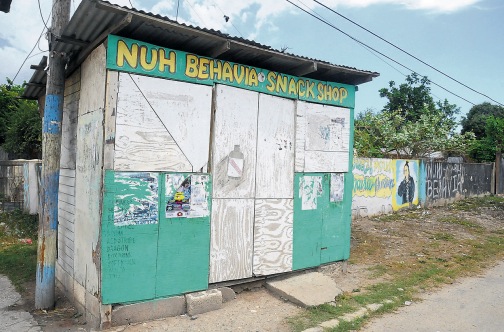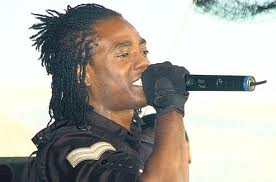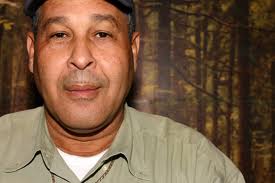Nuh Behavia Snack Shop and a portrait of Kiprich are located at the entrance of Trinidad Road.—-
The Jamaica Observer continues its series called Pon Di Ends which features communities that have influenced Jamaica’s music.
AFTER a few minutes with deejay Kiprich in Waterhouse, it was clear the deejay is a favourite among residents of the rugged Kingston community.
At the entrance to Trinidad Road, where the entertainer spent some of his youth, the words Nuh Behavia (a phrase made popular by Kiprich) are painted on a shop which is near to a wall with a large portrait of Kiprich.
“Other than the entertainers who live here a da man here and God give back to the community often,” a youngster shouted, before riding off on a bicycle.
Kiprich was actually born in Linstead, St Catherine, but relocated to Waterhouse as a boy.
Located in the constituency of St Andrew South, Waterhouse is known to many as an inner-city area plagued by violence and poverty. However, it has an impressive music legacy.
The community has produced some of dancehall and reggae’s finest artists and producers including Grammy winners Black Uhuru and Beenie Man, singer Junior Reid, deejay Powerman, and engineer/producers Osbourne ‘King Tubby’s’ Ruddock, Lloyd ‘King Jammy’s’ James and Bobby ‘Bobby Digital’ Dixon.
“Persons just naturally love music here. As a child growing up I was inspired by all the entertainers that lived here…I just wanted to be like them,” Kiprich told Splash.
According to the entertainer, whose real name is Marlon Plunkett, he knew from early that he wanted a career in music.
“My mother had a shop and whenever persons come to make a purchase, in addition to getting their goods my friends and I would put on a show for them,” he recalled, laughing.
His dream became reality while attending Ardenne High School. He got his breakthrough hit in 1999 with Leggo Di Bwoy, a collaboration with singer Chino.
Waterhouse was the inspiration for some of his songs including Real Bad Man no Snitch and Cut Him Off.
Music was not all Kiprich was exposed to as a youth. Persistent violence rocked Waterhouse.
“A few of my friends died young here. Some of whom had the potential to be successful, whether in music or other career choices. I have learned a lot here. I have seen everything and this community teaches me to be street-smart,” he said.
Just blocks away from Trinidad Road is St Lucia Road, home of the famous King Jammy’s studio. It is where Kiprich recorded songs like Anger and Blow, a collaboration with Lisa Hyper.
The historic 1984 hit song Under Mi Sleng Teng was also cut at King Jammy’s base; dancehall heavyweights Super Cat, Admiral Bailey, Pinchers and Frankie Paul all recorded hits there.
- Lloyd “King Jammys” James
According to Kiprich, who visits Waterhouse frequently, the community is calmer now.
“There is a mixture of people living here, some of whom are employed to corporate Jamaica, but we all know that they have to give wrong address on their résumés. The place is settled and everyone is trying to hold the peace,” he said. “Instead of investing in guns, the youths are becoming party promoters; a lot of street dances are hosted here,” Kiprich pointed out.
In his near 20-year career, Kiprich has earned a reputation for comedic songs and lyrical confrontations with other artists.
His conquests include Merciless at Sting 2011. And in 2008, he trounced the three-member Monster Shack Crew. Among his recent hit singles are The Letter, Telephone Ting and Noh Bruk Di Law.
He mentors upcoming artists such as Kym, Nemsi and Microwave on his Nuh Behavia label.
After ‘chilling’ with his friends for a few hours, Kiprich left yesterday for gigs in Guyana.













